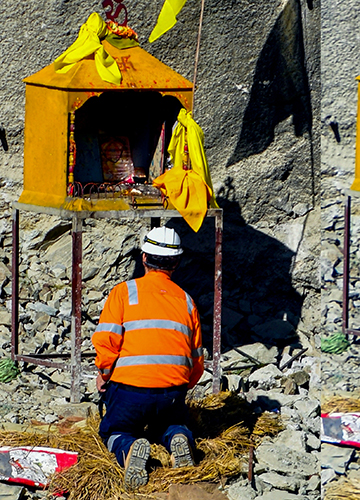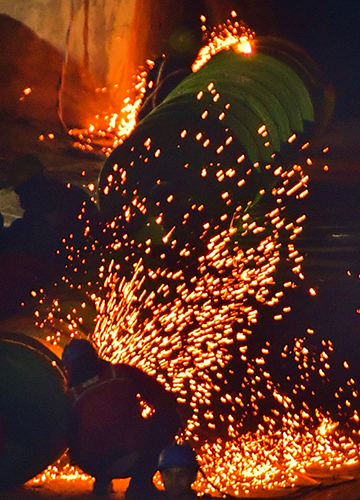Myths, folklore and legends have an extraordinary place in India. More so in the Himalayan region up north, especially in Uttarakhand, considered ‘Dev Bhoomi’ or the land of the gods. The sudden collapse of an under-construction ‘strategic’ tunnel to connect Silkyara with Barkot, two one-horse highway settlements in Uttarkashi district on November 12 has led to certain uneasiness among locals. They point at divine wrath. On completion, the tunnel―part of the Char Dham Pariyojana, the highway project linking the four main shrines of Uttarakhand―would connect Gangotri and Yamunotri much more easily, with pilgrims not having to traverse the Radi pass that dominates the surrounding mountainous geography.
Huddled in an animated conversation with his friends on why the tunnel caved in, trapping 41 workers, Madan Bhandari, a wiry local from nearby Chinyalisour, told THE WEEK: “There was a temple dedicated to Baba Baukh Naag, our main deity, on the spot where the tunnel begins from the Silkyara side. Despite our reservations, the temple was dismantled without the necessary religious ceremonies. And the result is there for everyone to see. Obstacles have come up in the tunnel work at every step. Unless quickly addressed, it will lead to more such disasters.”
Bhandari is at the tunnel site with four of his friends to witness the rescue operations. “The trapped workers are alive only because of the benevolence of Baba Baukh Naag. They will come out alive if Baba is pacified.” Bhandari points towards the peak that overlooks the tunnel site. “That is where the main Baukh Naag temple is located. Every three years a grand fair is held where locals climb up the peak to pay obeisance to the deity,” he said. Garwalis worship Baba Baukh Naag as one of the manifestations of Shiva.
Most local people seem to agree with Bhandari. Mamta, who runs a small highway lodge at Brahmkhal, about 5km from the tunnel, said there was a definite link between the accident and the manner in which the earlier temple was dismantled.
The linking of natural disasters with divine wrath is not new. In 2013, after the massive deluge in Kedarnath, local people blamed it on the relocation of the Dhari Devi shrine during the construction of the Alaknanda hydroelectric project. The disaster claimed more than 6,000 lives and affected around 4,500 villages. Dhari Devi is worshipped as the guardian deity of the Char Dhams (shrines) of Kedarnath, Badrinath, Gangotri and Yamunotri. A glacier burst on February 7, 2021, in Chamoli district near Uttarkashi had claimed about 200 lives, with many being trapped inside the tunnels of hydroelectric projects. Then, too, there was talk about divine wrath. As if in acquiescence, the National Highways and Infrastructure Development Corporation Limited (NHIDCL)―the state-owned company that is overseeing the tunnel construction at Silkyara, undertook a small ritual presided by a local priest and installed a small temple on the mouth of the tunnel on November 18.
THE WEEK has learnt that several such cave-ins have taken place since the construction started in 2019. “Cave-ins during excavation are not unusual. It was unfortunate that this time, 41 workers got trapped,” said an official closely associated with the tunnel work. “The accident took place when the workers were laying out the ‘final lining’ on that particular tunnel stretch.”
The official explained that after the completion of excavation, a primary lining of the tunnel is done. And if the condition of the rock is good, the final lining is also completed at one go. But if the rock condition is not good, then only the primary lining is done and the final lining will be done later. Primary lining involves fixing steel rims along with the initial level of concreting. Final lining is done with steel girdles and final concreting after getting the exact dimensions of the tunnel.
“Before selecting a site for tunnel construction, extensive studies are to be conducted. These studies typically involve geological mapping, geophysical investigations, geo-technical investigations and risk assessments to evaluate factors like rock stability, water ingress and seismic activity,” said Sanjay Rana, a geophysical expert with extensive experience in tunnel investigations. “Such information is vital for determining the feasibility, safety and design of the tunnel. It is, however, important to note that despite advances in technology, the full potential of geophysics in tunnelling is still not fully utilised. It can lead to gaps in our understanding of subsurface conditions, potentially impacting the safety and stability of tunnel projects.” The collapse of a section in a tunnel can be attributed to several factors, including geological surprises, construction errors or unexpected changes in geological conditions. “The Himalayas, being the world’s youngest fold mountains, present unique challenges for deep tunnelling. Their geological youth means they are still actively rising and are subject to various geological processes,” said Rana.
The accident, meanwhile, has been beneficial to small hotel owners like Mamta, as it has led to a rush of visitors even after the end of the Char Dham pilgrimage season. The season ended with Diwali on November 12, the same day the tunnel caved in. During the season, pilgrims stop along roadside hotels like Mamta’s for food and accommodation. Journalists, government officials and rescue workers have taken their place now. “All my rooms are booked,” said Mamta.
The NHIDCL is among the agencies that are leading rescue operations. It is under NHIDCL’s guidance that the private contracting firm, Navyug Engineering Company, has been constructing the tunnel. Besides NHIDCL, other main agencies mandated with rescue efforts include the Oil and Natural Gas Corporation, the Satluj Jal Vidyut Nigam, the Rail Vikas Nigam Limited and the Tehri Hydro Development Corporation Limited. The Border Roads Organisation and the National Disaster Response Force (NDRF) wait on the sidelines awaiting further orders.
The ill-fated tunnel, estimated to be 4,531m-long, would have bored through a mountain ridge that divides the ‘Ganga valley’ in the south (Silkyara side) with the ‘Yamuna valley’ in the north (Barkot side)―local parlance for the Gangotri and the Yamunotri shrines. So far, 2,340m from the Silkyara side and 1,600m from the Barkot side have been completed. It would provide much faster and easier all-weather connectivity to places like the Harsil sector near the Sino-Indian border, by shortening the existing 26km-long, landslide-prone road, to just 4.5km, drastically cutting back on travel time from about an hour to just a few minutes.
Lieutenant General Rakesh Sharma (retired), who had served in the central sector of the Sino-Indian border, said it was important to have a tunnel in this stretch to avoid travelling 26km through difficult terrain going up the hills and then coming down. “The areas in the central sector like the Harsil sector or the Nelang sector are, in a sense, areas under dispute with the Chinese. So the road, besides facilitating the Char Dham pilgrims, are also facilitating military movement. It must be understood that all-year connectivity is not just for religious and pilgrimage purposes, but also for military movement that have strategic significance,” he said. “There are distinct advantages in constructing these tunnels, and accidents happen. Rather than deterring us, they should encourage us to plan it better and safer.”
The project will get further teeth from December 1 when the Forest (Conservation) Amendment Act, 2023, comes into effect. The new law will address a long pending grouse of the Army that blames the bureaucracy of stalling forest and environmental clearances to strategic road construction projects. The Act will exempt up to 100km from the border―in the entire sweep along the Line of Actual Control (LAC) with China and the Line of Control (LoC) with Pakistan―permitting road construction and setting up of military infrastructure.
The tunnel disaster has also given an opportunity to the Indian Air Force to undertake non-routine critical operations and land its C-130J Super Hercules in the 3,600ft-long ‘rudimentary and unfeasible’ advanced landing ground at Dharasu, located at more than 4,000ft above sea level. The Super Hercules transported heavy boring equipment to rescue the trapped workers. Such experience would come in handy during exigencies.
With the Himalayas located in seismic zone five―the highest level of seismicity―a major point of concern is the suitability of deep tunnelling in the Himalayas. Vineet Gahalaut, chief scientist at the National Geophysical Research Institute, Hyderabad, said if a region was deemed seismically very active, it was important to make stronger structures. “Accidents like the tunnel caving in are usually referred to as ‘geological surprises’. Such ‘surprises’ are encountered because there is lack of proper study and analysis in the first place,” he said. “We have building codes even for seismic zone five. But you have to do the ground work and map the entire region to avoid geological ‘surprises’.”
With scores of journalists―local, national and international―camped in the area for the past several days, the site of the ill-fated tunnel has turned into a media spectacle. The information and broadcasting ministry has issued an advisory asking television channels “to refrain from sensationalising the issue and from undertaking any live posts/videos from close proximity of the tunnel site where rescue operations are underway.”
Also Read
- Uttarakhand CM Dhami performs pran pratishtha for the Baba Baukh Nag temple near Silkyara tunnel
- Uttarakhand: A totem of hope or a tomb of recklessness?
- 'Tourism cannot mean we harm the environment': Uttarakhand CM Dhami
- What's worsening Uttarakhand's fragile ecosystem
- Why Uttarakhand is at the cusp of a tragedy of epic proportions
- Nainital's future is threatened by gradual killing off of its main water source
In the surrounding din, groups of tunnel workers in their yellow hard hats huddle together, seemingly feeling out of place. Invariably, a ‘class’ dimension creeps in. For Rajesh Kumar (name changed), a 32-year-old who works for one of the agencies involved, there seems to be no urgency in the rescue operations, although 41 workers remain trapped. “Everyone is talking of several plans of action. Why couldn’t they pursue all these plans simultaneously? It is because there are no engineers and officials trapped inside. It is only poor workers like us,” said Rajesh, who is from Jharkhand. Of the 41 workers trapped inside, 15 are from Jharkhand, eight from Uttar Pradesh, five each from Odisha and Bihar, three from West Bengal, two each from Assam and Uttarakhand, and one from Himachal Pradesh.
As the country gets ready for general elections, it will be interesting to see how finely the government manages to balance religious fervour, development needs and national security concerns with environmental and ecological challenges.
On November 21, Bhaskar Khulbe, officer on special duty in the Uttarakhand government who oversees the rescue operations in Silkyara, had to fly out to take his ailing wife to hospital. He was back the next morning. “The four aspects―faith, along with developmental, strategic and connectivity objectives―are like the four lions in our national emblem,” said Khulbe, who was adviser to the prime minister. “The last three are visible from the front, with faith governing them from behind. Satyameva Jayate (truth shall triumph) should be the end result.”




